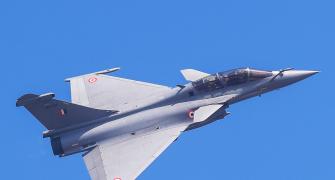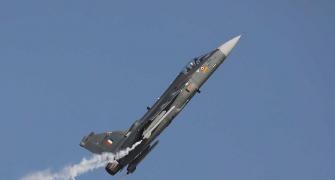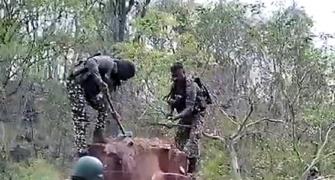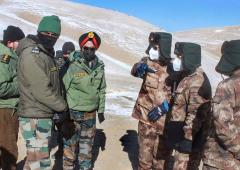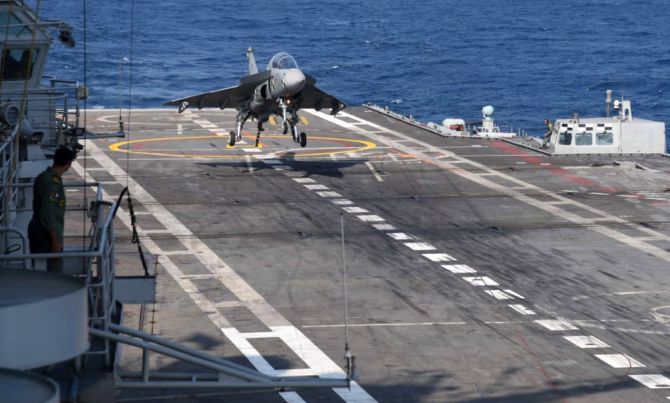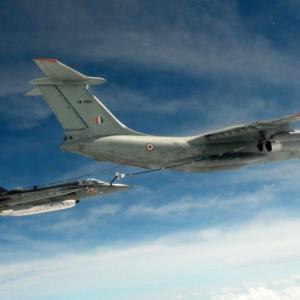The Tejas Mark 1A outperforms the Sino-Pakistan JF-17 Thunder in avionics and weaponry, but the finance ministry's tax burden makes the Indian LCA costlier and hurts it in the export market.
Ajai Shukla reports.
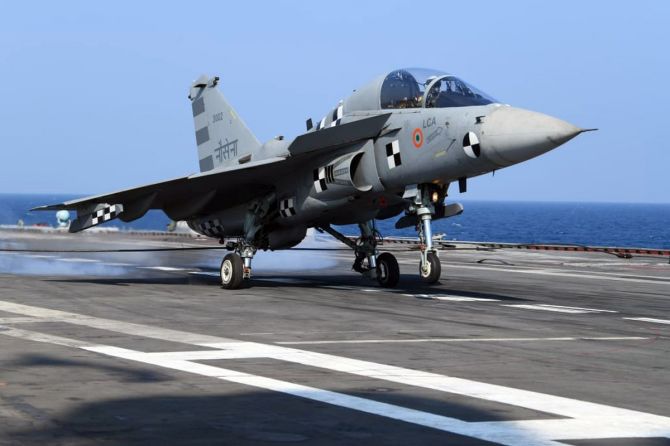
The ministry of defence announced the Union Cabinet's clearance for Hindustan Aeronautics to build 83 Tejas Mark 1A light combat aircraft for Rs 45,696 crore (Rs 456.96 billion).
This raised concerns that the improved version of the current Tejas Mark 1 fighter would cost a daunting Rs 550 crore (rs 5.5 billion) each.
However, senior government sources have clarified that each Tejas Mark 1A will cost no more than Rs 315 crore (Rs 3.15 billion) to build, with the total manufacturing cost adding up to Rs 26,145 crore (Rs 261.45 billion).
The balance of the Cabinet clearance includes allocations for tax and for maintenance and support infrastructure in the two operational air bases that will be home to the four squadrons of the Tejas Mark 1A.
Of the Cabinet's total allocation, government taxes and levies constitute about 20 per cent, or about Rs 9,000 crore (Rs 90 billion). Effectively, the ministry of finance will be appropriating a large chunk of the defence budget through taxing an indigenous weapons platform.
In major arms manufacturing countries, such as the US, defence equipment and weaponry is exempt from excise and sales tax.
True, taxation of defence equipment merely amounts to money going from one government pocket to another. However, it would have serious implications when it comes to export of the Tejas Mark 1A.
The government has emphasised the need for promoting export, which would reduce the fighter's cost through manufacture in larger numbers.
At Rs 315 crore ($43 million) per fighter, the Tejas Mark 1A would be a viable competitor in the international market for light fighters. It would be less so if taxes took up its cost to Rs 385 crore/Rs 3.85 billion ($53 million).
Competitors, such as the Sino-Pakistan JF-17 Thunder, are cheaper with a unit cost of $25 million-$30 million. However, the Tejas Mark 1A outperforms them in avionics and weaponry.
This is through performance enhancements introduced into the Tejas Mark 1A, compared to the current Mark 1. The Mark 1A features the Israeli Elta EL/AESA 2052 active electronically scanned array (AESA) radar, replacing the Mark 1's manually scanned Elta EL/M 2032 radar.
None of the light fighters competing with the Tejas features an AESA radar, which provides a massive advantage in air-to-air as well as air-to-ground combat.
The Tejas Mark 1A also scores in electronic warfare, being equipped with an Israeli self-protection jammer, carried in an external pod under the fighter's wing.
Finally, an operational edge is provided by the Mark 1A's air-to-air missiles. Its primary 'beyond visual range' missile is the indigenous Astra, one of the Defence Research and Development Organisation's outstanding successes.
In addition, the Mark 1A is integrated with the shorter-range ASRAAM missile, built by European consortium, MBDA; and with the Israeli Derby and Russian R-73 missiles.
While the Tejas LCA programme has been run by the DRDO, through an organisation called the Aeronautical Development Agency, developing and manufacturing the Tejas Mark 1A was entrusted to HAL.
However, ADA, which holds all the source codes of the Tejas, charged HAL a sum of Rs 800 crore (Rs 8 billion) for its partnership.
The amount cleared by the Cabinet also includes expenditure on setting up operational infrastructure for flying the Tejas Mark 1A from two Indian Air Force bases, which are still unidentified. Each airbase will house two Tejas Mark 1A squadrons.
Each of these two airbases will operate a technical training school, in which maintenance technicians and even pilots will undergo continuous training and upgrading of their technical skills. The cost of setting up each of these training establishments will be over Rs 300 crore (Rs 3 billion).
An expenditure of Rs 1,202 crore (Rs 12.02 billion) has also been budgeted for setting up 'ground support equipment' and 'ground handling equipment' in both the Tejas Mark 1A airbases.
This equipment is required for the ground end of flying operations -- getting the fighter aircraft started up and airborne, carrying out maintenance checks and a certain level of repair and replacement of modules.
A large sum has been cleared for the Tejas Mark 1A's 'maintenance running list of spares', which is a large inventory of spares and modules that operational squadrons and depots holds in reserve.
This is so that, in the event of an aircraft component or module requiring to be replaced, it is readily available and there is no waiting period while the part is obtained from a central depot far away.
IAF sources indicate that HAL initially submitted a cost estimate of Rs 59,000 crore (Rs 590 billion), which was brought down by the Cost Negotiation Committee by Rs 12,000 crore (Rs 120 billion).
In fact, the reason for HAL's high initial estimate was the IAF's demand that the Tejas fighter's engine -- the F-404IN engine, built by the US firm General Electric -- be manufactured in India with transfer of technology from GE.
Eventually, this plan was dropped due to the high cost demanded by GE for transfer of technology and licence to build the F-404IN engine in India. Buying ready-built engines from GE brought down the project cost by Rs 12,000 crore.


